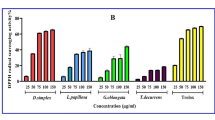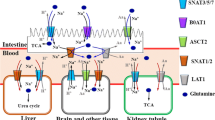Abstract
We explored the synergistic effect of serine combined with several selenocompounds or used alone on the expression of selenoprotein P (SelP) and glutathione peroxidase (GPx) in this study. We first compared the SelP and GPx expression difference between HepG2 and Hela cells treated with serine and finally chose HepG2 as experimental cell. In the serine-used-alone experiment, three kinds of selenium nutritional models (low-, adequate-, and high-selenium) were established and serine was 10 times gradient diluted (0.01 to 100 μmol/L). In the combined experiment, the selenocompound doses were set as 0.01, 0.1, and 1 μmol Se/L and serine was set according to its molar ratio with the selenocompounds. We found that SelP and GPx concentrations in the low-, adequate-, and high-selenium models increased following with serine dose. When the concentration of sodium selenite and SeMet was 1 μmol Se/L while MeSeCys was 0.1 and 1 μmol Se/L, SelP concentrations for serine combined with selenocompounds groups were significantly higher than that of selenocompounds used alone. When the concentration of sodium selenite was 0.1 μmol Se/L, SeMet was 0.1 and 1 μmol Se/L while MeSeCys was 0.01 and 1 μmol Se/L, GPx concentrations for serine combined with selenocompounds groups were significantly higher than that of selenocompounds used alone. Our preliminary result indicated the beneficial effect of serine on the expression of SelP and GPx, which suggested that it might be a candidate for combined selenium supplement.



Similar content being viewed by others
References
Duntas LH, Benvenga S (2015) Selenium: an element for life. Endocrine 48:756–775
Muth OH, Oldfield JE, Remmert LF, Schubert JR (1958) Effects of selenium and vitamin E on white muscle disease. Science 128:1090
Keshan Disease Research Group of the Chinese Academy of Medical Sciences (1979) Observations on effect of sodium selenite in prevention of Keshan disease. Chin Med J (Engl) 92:471–476
Moreno-Reyes R, Mathieu F, Boelaert M, Begaux F, Suetens C, Rivera MT, Nève J, Perlmutter N, Vanderpas J (2003) Selenium and iodine supplementation of rural Tibetan children affected by Kashin-Beck osteoarthropathy. Am J Clin Nutr 78:137–144
Li Q, Zhao ZJ, Yang PZ, Xu XQ, Liu YF, Yu HZ, Ma X, Du R, Zhu L (2015) The prevention effect of selenium on prevalence of children Kashin-Beck disease in active endemic areas in Qinghai plateau. Biol Trace Elem Res. doi:10.1007/s12011-015-0394-4
Alfthan G, Xu GL, Tan WH, Aro A, Wu J, Yang YX, Liang WS, Xue WL, Kong LH (2000) Selenium supplementation of children in a selenium-deficient area in China: blood selenium levels and glutathione peroxidase activities. Biol Trace Elem Res 73:113–125
Değer Y, Mert H, Mert N, Yur F, Kozat S, Yörük IH, Sel T (2008) Serum selenium, vitamin E, and sialic acids concentrations in lambs with white muscle disease. Biol Trace Elem Res 121:39–43
Berry MJ, Banu L, Chen YY, Mandel SJ, Kieffer JD, Harney JW, Larsen PR (1991) Recognition of UGA as a selenocysteine codon in type I deiodinase requires sequences in the 3′ untranslated region. Nature 353:273–276
Wu XQ, Gross HJ (1993) The long extra arms of human tRNA((Ser)Sec) and tRNA(Ser) function as major identify elements for serylation in an orientation-dependent, but not sequence-specific manner. Nucleic Acids Res 21:5589–5594
Ohama T, Yang DC, Hatfield DL (1994) Selenocysteine tRNA and serine tRNA are aminoacylated by the same synthetase, but may manifest different identities with respect to the long extra arm. Arch Biochem Biophys 315:293–301
Amberg R, Mizutani T, Wu XQ, Gross HJ (1996) Selenocysteine synthesis in Mammalia: an identity switch from tRNA(Ser) to tRNA(Sec). J Mol Biol 263:8–19
Rotruck JT, Pope AL, Ganther HE, Swanson AB, Hafeman DG, Hoekstra WG (1973) Selenium: biochemical role as a component of glutathione peroxidase. Science 179:588–590
Schweizer U, Streckfuss F, Pelt P, Carlson BA, Hatfield DL, Köhrle J, Schomburg L (2005) Hepatically derived selenoprotein P is a key factor for kidney but not for brain selenium supply. Biochem J 386:221–226
Zeng H, Botnen JH, Johnson LK (2008) A selenium-deficient Caco-2 cell model for assessing differential incorporation of chemical or food selenium into glutathione peroxidase. Biol Trace Elem Res 123:98–108
Hollenbach B, Morgenthaler NG, Struck J, Alonso C, Bergmann A, Köhrle J, Schomburg L (2008) New assay for the measurement of selenoprotein P as a sepsis biomarker from serum. J Trace Elem Med Biol 22:24–32
Thiry C, Ruttens A, Pussemier L, Schneider YJ (2013) An in vitro investigation of species-dependent intestinal transport of selenium and the impact of this process on selenium bioavailability. Br J Nutr 109:2126–2134
Hoefig CS, Renko K, Köhrle J, Birringer M, Schomburg L (2011) Comparison of different selenocompounds with respect to nutritional value vs. toxicity using liver cells in culture. J Nutr Biochem 22:945–955
Xia Y, Hill KE, Byrne DW, Xu J, Burk RF (2005) Effectiveness of selenium supplements in a low-selenium area of China. Am J Clin Nutr 81:829–834
Burk RF, Norsworthy BK, Hill KE, Motley AK, Byrne DW (2006) Effects of chemical form of selenium on plasma biomarkers in a high-dose human supplementation trial. Cancer Epidemiol Biomarkers Prev 15:804–810
Suzuki KT, Doi C, Suzuki N (2006) Metabolism of 76 Se-methylselenocysteine compared with that of 77 Se-selenomethionine and 82 Se-selenite. Toxicol Appl Pharmacol 217:185–195
Jackson-Rosario SE, Self WT (2010) Targeting selenium metabolism and selenoproteins: novel avenues for drug discovery. Metallomics 2:112–116
Kieliszek M, Błażejak S, Gientka I, Bzducha-Wróbel A (2015) Accumulation and metabolism of selenium by yeast cells. Appl Microbiol Biotechnol 99:5373–5382
Burk RF, Hill KE (2015) Regulation of selenium metabolism and transport. Annu Rev Nutr 35:109–134
Fairweather-Tait SJ, Collings R, Hurst R (2010) Selenium bioavailability: current knowledge and future research requirements. Am J Clin Nutr 91:1484S–1491S
Ning YJ, Wang X, Ren L, Guo X (2013) Effects of dietary factors on selenium levels of children to prevent Kashin-Beck disease during a high-prevalence period in an endemic area: a cohort study. Biol Trace Elem Res 153:58–68
Ning Y, Wang X, Wang S, Zhang F, Zhang L, Lei Y, Guo X (2015) Is it the appropriate time to stop applying selenium enriched salt in Kashin-Beck disease areas in China? Nutrients 7:6195–6212
Miski AM, Kratzer FH (1977) Effects of dietary protein, glycine, and tryptophan on iron metabolism in the growing chick. J Nutr 107:24–34
Greger JL, Snedeker SM (1980) Effect of dietary protein and phosphorus levels on the utilization of zinc, copper and manganese by adult males. J Nutr 110:2243–2253
Bunker VW, Lawson MS, Stansfield MF, Clayton BE (1988) Selenium balance studies in apparently healthy and housebound elderly people eating self-selected diets. Br J Nutr 59:171–180
Nagy G, Benko I, Kiraly G, Voros O, Tanczos B, Sztrik A, Takács T, Pocsi I, Prokisch J, Banfalvi G (2015) Cellular and nephrotoxicity of selenium species. J Trace Elem Med Biol 30:160–170
Brodin O, Eksborg S, Wallenberg M, Asker-Hagelberg C, Larsen EH, Mohlkert D, Lenneby-Helleday C, Jacobsson H, Linder S, Misra S, Björnstedt M (2015) Pharmacokinetics and toxicity of sodium selenite in the treatment of patients with carcinoma in a phase I clinical trial: the SECAR study. Nutrients 7:4978–4994
Misra S, Boylan M, Selvam A, Spallholz JE, Björnstedt M (2015) Redox-active selenium compounds—from toxicity and cell death to cancer treatment. Nutrients 7:3536–3556
Flores Villavicencio LL, Cruz-Jiménez G, Barbosa-Sabanero G, Kornhauser-Araujo C, Mendoza-Garrido ME, de la Rosa G, Sabanero-López M (2014) Human lung cancer cell line A-549 ATCC is differentially affected by supranutritional organic and inorganic selenium. Bioinorg Chem Appl 2014:923834
Wei J, Zeng C, Gong QY, Yang HB, Li XX, Lei GH, Yang TB (2015) The association between dietary selenium intake and diabetes: a cross-sectional study among middle-aged and older adults. Nutr J 14:18
Yuan Z, Xu X, Ye H, Jin L, Zhang X, Zhu Y (2015) High levels of plasma selenium are associated with metabolic syndrome and elevated fasting plasma glucose in a Chinese population: a case-control study. J Trace Elem Med Biol 32:189–194
Shaheen R, Rahbeeni Z, Alhashem A, Faqeih E, Zhao Q, Xiong Y, Almoisheer A, Al-Qattan SM, Almadani HA, Al-Onazi N, Al-Baqawi BS, Saleh MA, Alkuraya FS (2014) Neu-Laxova syndrome, an inborn error of serine metabolism, is caused by mutations in PHGDH. Am J Hum Genet 94:898–904
Acuna-Hidalgo R, Schanze D, Kariminejad A et al (2014) Neu-Laxova syndrome is a heterogeneous metabolic disorder caused by defects in enzymes of the L-serine biosynthesis pathway. Am J Hum Genet 95:285–293
Garofalo K, Penno A, Schmidt BP, Lee HJ, Frosch MP, von Eckardstein A, Brown RH, Hornemann T, Eichler FS (2011) Oral L-serine supplementation reduces production of neurotoxic deoxysphingolipids in mice and humans with hereditary sensory autonomic neuropathy type 1. J Clin Invest 121:4735–4745
Van Horn MR, Sild M, Ruthazer ES (2013) D-serine as a gliotransmitter and its roles in brain development and disease. Front Cell Neurosci 7:39
Fukada S, Shimada Y, Morita T, Sugiyama K (2006) Suppression of methionine-induced hyperhomocysteinemia by glycine and serine in rats. Biosci Biotechnol Biochem 70:2403–2409
Liu YQ, Liu Y, Morita T, Sugiyama K (2011) Methionine and serine synergistically suppress hyperhomocysteinemia induced by choline deficiency, but not by guanidinoacetic acid, in rats fed a low casein diet. Biosci Biotechnol Biochem 75:2333–2339
Acknowledgments
All authors read and approved the final manuscript. This study was financially supported by the National Natural Science Foundation of China under the Grant No. 81372989. Q. W. specially thanks Prof. Y. Hu at the Key Laboratory for Biomedical Effects of Nanomaterials and Nanosafety, Chinese Academy of Sciences, for helpful discussions. She also acknowledges hospitality of the staff there during her recent visit to the laboratory.
Author information
Authors and Affiliations
Corresponding author
Rights and permissions
About this article
Cite this article
Wang, Q., Sun, Lc., Liu, Yq. et al. The Synergistic Effect of Serine with Selenocompounds on the Expression of SelP and GPx in HepG2 Cells. Biol Trace Elem Res 173, 291–296 (2016). https://doi.org/10.1007/s12011-016-0665-8
Received:
Accepted:
Published:
Issue Date:
DOI: https://doi.org/10.1007/s12011-016-0665-8




